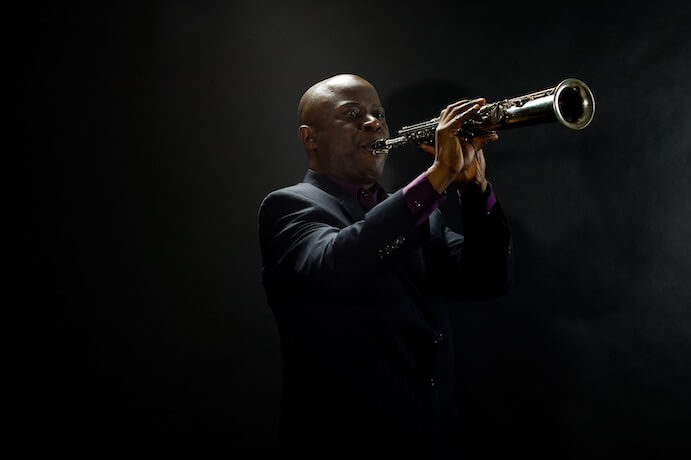For twenty-five years, Sam Newsome has pursued an unrelenting artistic journey to refine a uniquely authentic sound and expansive musical vocabulary on the soprano saxophone. Newsome found initial success with a flexible tone on the notoriously finicky instrument along with a stylistic sensitivity through collaborations in genres ranging from straight ahead jazz to world music. While these elements are foundational to Newsome’s ‘sound,’ they are germinal to more experimental efforts to increase the soprano saxophone’s sonic possibilities. Newsome has achieved novelty in improvisations across styles by routinely incorporating slap tongues, multiphonics, microtonal scales, and various textural overtone effects. His new album, Chaos Theory (2019-self released), documents his latest experimentations modifying the soprano saxophone to further extend the instrument’s sonic palette and create striking improvisations.
Newsome previously experimented with modifying, or preparing, his soprano saxophone on his 2017 album, Sopranoville: Works for Prepared and Non-Prepared Saxophone. Numerous demonstration videos on Newsome’s YouTube channel reveal that he has since gone to great lengths to expand the variety of methods by which he modifies his instrument. Lengths of plastic tubing between the mouthpiece and the body of the soprano result in low, gurgling harmonic overtones similar to those produced on a bass clarinet. Mutes, balloons, and other elastic materials placed over the bell allow the soprano to be played as a hand percussion instrument and give slap tongues a more complex resonance. In live performance, Newsome often utilizes expansive improvisations to explore these effects one by one, but on Chaos Theory, he distills the essence of these live improvisations into short poetic forms by layering prepared instrumental effects through multi-tracking and spatializing, achieving textures impossible in live performance.

Sam Newsome–Photo courtesy www.somenewmusic.com
Chaos Theory features two characteristically distinct song cycles whose movements are interspersed throughout the album. The album’s titular song cycle features varied textures created using the layering and spatializing technique. Opening the album, “Chaos Theory, No 1: Brewing” places an unmodified soprano solo in Newsome’s characteristic improvisational style amidst eclectic textural effects on the plastic tube extended soprano. Newsome’s solo draws attention as it meanders above cacophonous high pitched squeaks, gurgling multiphonics, and punctuating slap tongues.
“Chaos Theory, No 2: Hiss-Ology,” one of the album’s more inventive and successful assemblages, curates air sounds produced on a soprano saxophone without a mouthpiece. While one of the shorter tracks on the album, Newsome quickly draws the listener into a panoramic soundscape populated with ubiquitously soloistic tracks sounding pitched air gestures and puckering sounds. Returning to the soprano extended with plastic tubing, “Chaos Theory, No 3: Entrapment” develops a similarly heterogenous texture replete with gurgling multiphonics, harmonic effects, and slap tongues. The cycle closes with “Chaos Theory, No 4: Measured Mayhem,” featuring multiple frantic solos on an unmodified soprano over a percussive, ostinato slap tongue groove on a muted soprano, with low drones from the extended soprano.
The album’s second cycle comprises a series of four solos that more directly showcase Newsome’s experimental playing styles as well as the modifications to his saxophone. Beginning in the middle of the album, the cycle’s opening track, “Naked Truth,” provides a welcome break from the album’s pervasive use of multi-tracking with a solo on an unmodified saxophone. “From Down Under” features a continuous, undulating drone-like improvisation on the plastic tube extended soprano’s overtone partials. Newsome virtuosically sustains multiple partials simultaneously, developing distinct improvisational characters in each partial. On “Flutter Effect,” Newsome shifts to a more active, yet sonically delicate texture that draws the listener in through hushed, yet frenetic melodic motion in the soprano’s upper registers. Newsome creates captivating depth and density in this track by inflecting the linear melodic motion with a flutter tongue technique that allows multiple partials to sound simultaneously. “Chiming In” dramatically closes out the cycle and the album with an expansive and meditative melodic improvisation over an accompaniment of jingling chimes affixed to the body of Newsome’s soprano saxophone.

Sam Newsome–Photo courtesy www.somenewmusic.com
Throughout the album, Newsome intersperses works with thematically evocative titles, the more successful of which quickly develop distinct improvisational characters. “Tel Aviv,” for instance, draws from Newsome’s experience in many world musical traditions to expressively evoke cantillation styles. Other tracks use multi-tracking to establish now familiar percussive rhythmic grooves to support solo improvisational voices. While wittily catchy in case of “Bubble Mute Boogie” and “Urban Location,” such tracks in the context of the whole album can sound trite when compared to the complex textures found in the Chaos Theory cycle.
With Chaos Theory, Newsome continues to make headway on his project to redraw the soprano saxophone’s sonic boundaries. His commitment to a pan-genre and historically minded approach sets him from similarly-minded experimental saxophonists. With this focus and a tendency to develop new ideas over many solo records, Chaos Theory is likely only a strong overture to even more experimental, more refined music from Newsome.




















